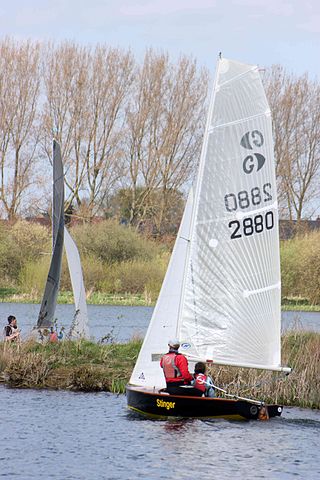
Dinghy sailing is the activity of sailing small boats by using five essential controls:
Bruce Kenneth Farr is a New Zealand designer of racing and cruising yachts. Farr‑designed boats have won, challenged for, or placed highly in the Whitbread Round the World Race, America's Cup, and Sydney to Hobart Yacht Race, among others.

Boat building is the design and construction of boats — and their on-board systems. This includes at minimum the construction of a hull, with any necessary propulsion, mechanical, navigation, safety and other service systems as the craft requires.
Strip-built, or "strip-plank epoxy", is a method of boat building. Also known as cold molding, the strip-built method is commonly used for canoes and kayaks, but also suitable for larger boats. The process involves securing narrow, flexible strips of wood edge-to-edge around temporary formers. The temporary formers are usually created via a process called "lofting" whereby a set of tables is used to generate the shapes of the formers. The strips are glued edge-to-edge with epoxy. It is effectively a modern form of carvel which needs no caulking and which is both stiffer and more watertight. In a small boat, there will be just one layer of strip-planking, but larger vessels may have two or three layers which,, forms a light, strong, and torsionally stiff monococque.

The OK Dinghy is an international class sailing dinghy, designed by Knud Olsen in 1956.

Philip C. Bolger was a prolific American boat designer, who was born and lived in Gloucester, Massachusetts. He began work full-time as a draftsman for boat designers Lindsay Lord and then John Hacker in the early 1950s.
The Velux 5 Oceans Race was a round-the-world single-handed yacht race, sailed in stages, managed by Clipper Ventures since 2000. Its most recent name comes from its main sponsor Velux. Originally known as the BOC Challenge, for the title sponsor BOC, the first edition was in 1982. In the late 1990s the race was renamed the Around Alone. The 2010-11 race was the last to take place and attracted just five entries. The event has not been held since.
Philippe Jeantot is a French former deep sea diver, who achieved recognition as a sailor for long-distance, single-handed racing and record-setting. He founded the Vendée Globe, a single-handed, round-the-world, non-stop yacht race.

The Graduate is a 12-foot sailing dinghy with a single-chine hull. Designed by Dick Wyche in 1952, the Graduate has a Bermuda rig.
The Norfolk Punt is a type of yacht, derived from the flat-bottomed gun punts that roamed the Broadland waters in the mid-to-late 19th century. However, at the turn of the 20th century, in order to get to and from the hunting grounds more quickly, the punters developed their highly unstable craft to carry a basic mast and sail for travelling with the wind. It is from these humble beginnings that one of the country's most exciting and powerful racing dinghy classes was born.

The Laser Vago is a British/American sailing dinghy that was designed by Jo Richards as a one-design racer and first built in 2005.
The Dabchick is a South African youth sailing dinghy that is raced two up or single-handed. A Bermuda rigged boat, it has a mainsail and jib. Its hull is very shallow and its skipper sits on its flat deck. This hard chined scow was designed by Jack Köper in 1955. Since they were published in 1956, nearly 3,500 plans have been issued to builders, and over 4,000 boats have been built. It is usually sailed by young crew with teenager skipper instead of the Optimist, before moving into higher performance classes.

The Gull sailing dinghy was designed by Ian Proctor in 1956, originally as a frameless double-chine plywood boat. However, it has been through several incarnations: the wooden Mark I, GRP Mark III, GRP Gull Spirit and GRP Gull Calypso. Today it is popular with sailing schools, especially in the United Kingdom.
Australian Sailing magazine (ASL) was published by Yaffa Publishing Group, an independent publisher headquartered in Surry Hills (NSW). Founded in 1976, it was Australia's only dedicated yacht racing magazine.

The sport of sailing involves a variety of competitive sailing formats that are sanctioned through various sailing federations and yacht clubs. Racing disciplines include matches within a fleet of sailing craft, between a pair thereof or among teams. Additionally, there are specialized competitions that include setting speed records. Racing formats include both closed courses and point-to-point contests; they may be in sheltered waters, coast-wise or on the open ocean. Most competitions are held within defined classes or ratings that either entail one type of sailing craft to ensure a contest primarily of skill or rating the sailing craft to create classifications or handicaps.

Phillip Edward "Ed" Baird is an American sailor. He was a coach of the 1995 America's Cup-winning Team New Zealand and a helmsman for the 2007 America's Cup-winning Alinghi syndicate.

The Farr 3.7 is a one-person sailing dinghy designed by Bruce Farr in 1971. The design plans are sold by the 3.7 Class Owners Association and they are built by a mix of professionals and home built by amateurs. The 3.7 Class is recognised by Yachting New Zealand as a national class and yachts are sailed in New Zealand, Australia and Great Britain. Full sets of plans have been sold worldwide to a number of individuals with greatest numbers in Germany, Japan, USA, South Korea, Poland, France, Belgium, Russia, Spain, Uruguay.

Alan Newbury Payne AM was a naval architect born in England but who worked in Australia. His yacht designs were readily built by both professionals and amateurs, and remain well represented in the ocean-going and coastal yacht fleet.
Alan Nebauer is an Australian yachtsman who competed in the single-handed round-the-world 1994–95 BOC Challenge race aboard the yacht Newcastle Australia. Nebauer won two awards for his seamanship during the race, one of them for rescuing his British competitor Josh Hall, whose vessel foundered during the first leg from Charleston to Cape Town.

Dudley Dix is a yacht designer, of South African origin, now based in Virginia Beach, US. He graduated from the Westlawn School of Yacht Design. He is notable for having developed the "radius chine plywood" method as a basis for boat construction. Dix won the 1979 Cruising World Design Competition.












